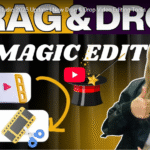How to Choose the Perfect Brand Colors: Lessons from Iconic Brands
Did you know that 90% of product judgments are based on colors? In this blog, we’ll dive into the fascinating world of brand colors and reveal how to pick the perfect palette to grab attention, evoke emotion, and make your brand unforgettable. Let’s get started!
Why Brand Colors Matter
Colors are more than just design elements; they’re a powerful psychological tool. The right color can evoke trust, excitement, or even hunger. Think about McDonald’s iconic red and yellow—bright, bold, and intentionally designed to stimulate appetite.
Choosing the wrong color, however, can confuse your audience or send the wrong message. That’s why it’s crucial to make sure your brand’s colors communicate exactly what you want them to.
Primary Colors vs. Creative Modern Colors
When selecting your brand colors, you have two main routes: Primary Colors or Creative Modern Colors.
- Primary Colors:
- Timeless and universally recognizable.
- Think Google or Lego—simple, strong, and memorable.
- Creative Modern Colors:
- Includes pastels, gradients, or neons.
- Perfect for brands that want to feel fresh, innovative, and exciting. Look at Airbnb or Slack—they stand out with unique palettes that scream modernity.
How to Choose Your Brand Colors
Now that you understand your options, here are five actionable tips to help you pick the perfect brand colors:
- Understand Color Psychology:
- Different colors evoke different emotions. For example:
- Blue conveys trust and professionalism.
- Yellow brings optimism and creativity.
- Match your colors to the feelings you want your brand to evoke.
- Different colors evoke different emotions. For example:
- Align with Your Brand Identity:
- Consider your brand’s personality. Are you:
- Fun and vibrant like a children’s brand?
- Sleek and professional like a tech company?
- Your colors should reflect who you are.
- Consider your brand’s personality. Are you:
- Research Your Competitors:
- Stand out while staying relevant to your industry.
- Avoid colors that look too similar to your competitors to ensure your brand doesn’t blend in.
- Build a Balanced Color Palette:
- Start with a primary color that represents your brand’s core identity.
- Add complementary secondary colors for variety and neutral tones for balance.
- A well-thought-out palette makes your brand versatile.
- Test for Accessibility and Versatility:
- Ensure your colors work across all platforms, from websites to social media to packaging.
- Test for contrast to guarantee readability and accessibility.
Examples of Successful Brand Color Choices
Let’s look at some brands that nailed their color choices:
- Coca-Cola: Their bold red creates energy and excitement.
- Spotify: Their fresh green feels innovative and dynamic.
- Apple: A sleek monochrome palette screams sophistication.
The secret? These brands align their colors perfectly with their identity and message.
Your Turn
Your brand colors are more than just a design choice—they’re a statement of who you are and what you stand for. So, which colors represent your brand? Take the time to explore your options, and create a palette that makes your brand unforgettable.
If you found this blog helpful, don’t forget to share it and leave a comment with your thoughts. Let’s grow together! See you next time!






